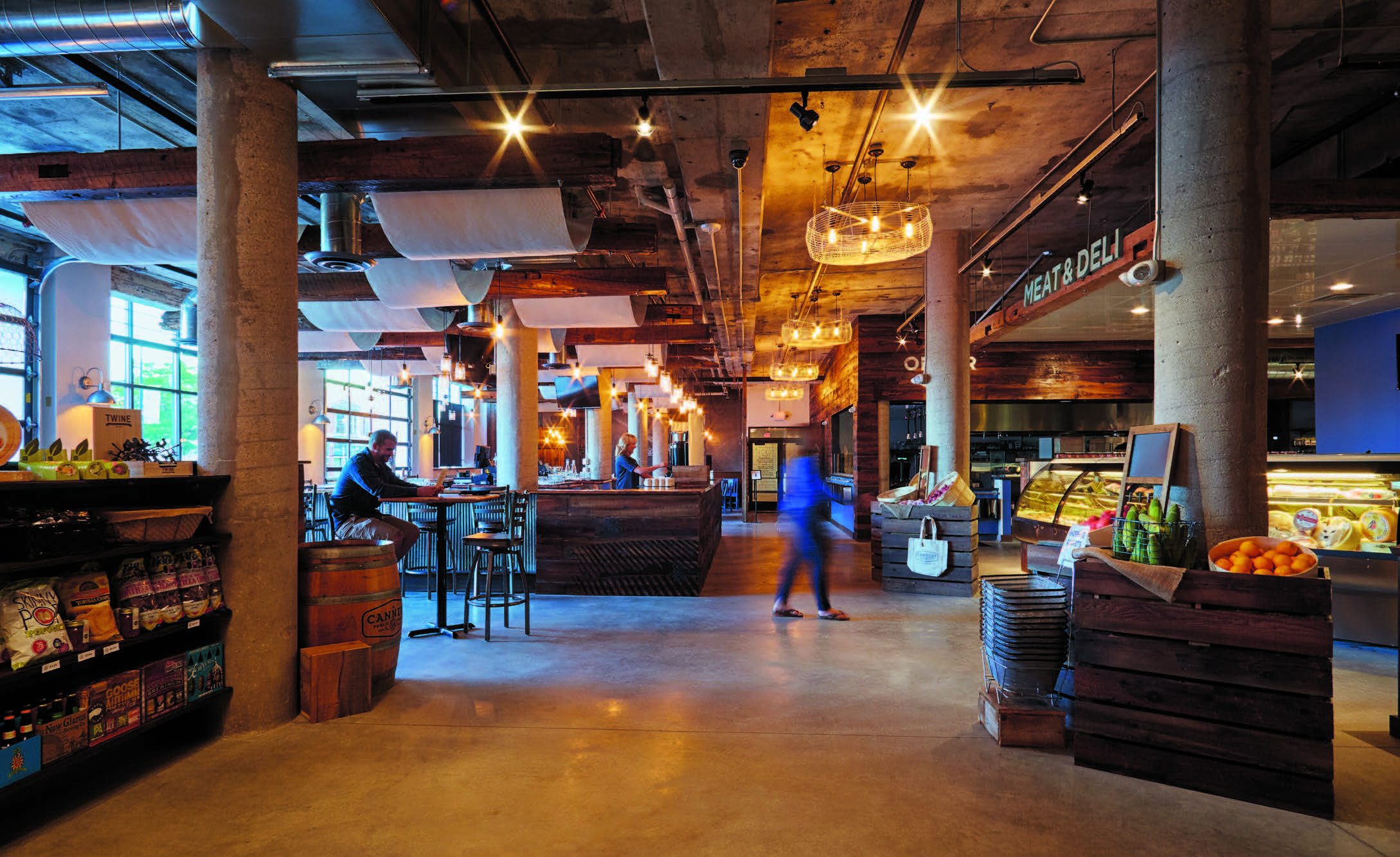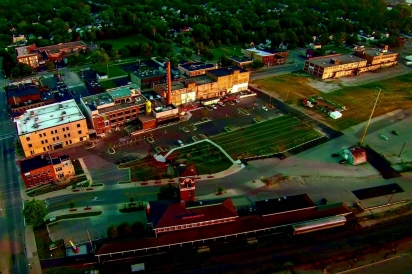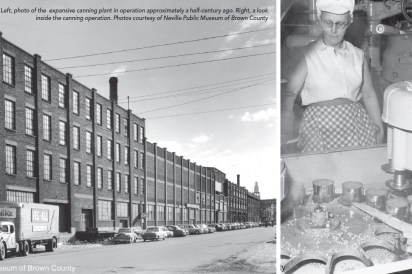Factory REBORN
LARSEN CANNERY BECOMES THE RAIL YARD
For years, the rough, red brick factory stood empty. It was an im- posing edifice perched on the edge of the lively downtown area in Green Bay. Situated on the end of the Broadway District, just behind the Titletown Brewery, it seemed almost forgotten.
The old canning factory held its ground since 1908. Once known as the The Larsen Canning Co., buildings and 22 acres of surrounding land have been recently renovated and renamed The Rail Yard.
It has come a long way.
In 1890, William Larsen decided to expand his wholesale fruit and vege- table business by starting The Larsen Canning Co. Raised in Door County, Larsen had started as a clerk in a Suamico general store. According to a piece in The Wisconsin Magazine, Larsen’s entrepreneurship led to later serving as a bank president and as the mayor of Fort Howard before it joined Green Bay.
The book Green Bay’s West Side: The Fort Howard Neighborhood, explains that Larsen built the old factory next to an old freight yard and engine house, which became the Chicago & North Western Railroad depot just a few years later in 1898. The original Larsen factory was replaced in 1908 by the concrete-and-brick structure that still stands today.
For years, the building on Broadway served as the main plant for the Larsen Canning Co.
The Green Bay Press-Gazette reported that the old cannery changed owners several times through the decades. In 1986, Dean Foods acquired the plant, which was known for brands including Freshlike and Veg-All. In 1998, it was bought by Agrilink and the name was later changed to Birds Eye Foods.
The building and surrounding land were eventually sold to On Broad- way Inc., and its fate hung in the balance. It was considered for a number of different uses, but, as the building fell into disrepair, many considered demolishing the buildings.
However, hope arrived as developers began considering how saving historic buildings impacted the area.
“It probably started back in the late nineties when Titletown took over the old train station,” says Kevin Vonck, development director for the City of Green Bay. “They saw the long-term vision: what this area could poten- tially grow into. Within the last 10 years, there has been a renewed interest in downtown and in historic buildings.”
After the success of their restaurant, bar and brewery in the former train depot, Titletown needed more space.
“We were looking to grow the brewing side of our business, and there were these turn-of-the-century warehouses just 100 feet away,” says Brent Weycker, president and founder of Titletown Brewing Company. “We were seeing a lot of old buildings being torn down. For us to adapt and reuse these is a big part of what we were trying to accomplish.”
The Rail Yard, including the Larsen buildings, is owned by DDL Holdings, which is a joint venture of Titletown Brewing Co. and Smet Construction.
The Larsen buildings sit on the edge of the commercial district on Broadway. The transformation from derelict to bustling is encouraging growth in the surrounding neighborhoods.
“Renovating historic structures is rewarding,” says Paul Belschner of DDL Holdings. “It took one major tenant to move this project forward and that was Titletown. That got the project started, and, from there, the momentum has just continued to grow.”
One key focus for the project is to keep and bring young professionals to Green Bay by creating fresh spaces like those in the Larsen buildings,
“Our decisions aren’t always real estate decisions; they are lifestyle decisions,” Belschner said. “The next genera- tion is looking for an experience. It’s live, work, play.”
Most of the spaces in the buildings were developed to appeal to office tenants like SharpLogixx, IGenFuels, and Khrome Advertising Agency. However, it is also creating communal spaces for socializing.
The Cannery Public Market joins Titletown in bringing unique dining and drinking experiences to the area. After a refreshing Yoga & Beer event in the Tap Room, local residents can enjoy delicious farm to table food. The banquet spaces are popular for local community events and weddings.
“Food and urban ar- eas go together well. Open-concept meeting spaces, event spaces and places where the community can come together provide op- por tunities to share and enjoy,” Vonck said. “People want a walk- able city. They want to be where things are happening. This renovation solidifies our ef- forts to build up our downtown core and it helps to revitalize a lot of our closed-in neighborhoods.”
To honor the history of the buildings, an effort was made to preserve and salvage as much of the original structure and features as possible. While some of the building is new, like Titletown’s Roof Tap bar, the new construction feels like an extension of the original Larsen building.
Fire doors were made into fireplaces. Some of the old elevator shafts became conference rooms. Inside Titletown’s new space, pieces of ma- chinery from the building’s past decorate the walls. The large gear that rotated the crane system when they pressure-cooked the vegetables is now displayed in the Tap Room. Incorporating materials from the old canning company creates a consistent industrial feel throughout.
The history of the factory is celebrated throughout the hallways of the buildings. Framed posters of the Veg-All and Freshlike vegeta- bles that were canned right in that building hang between old photos and stories.
Renovating historic buildings can have a massive impact on the com- munity. It can raise surrounding property values and inspire other revi- talization projects.
“[The Rail Yard] is adding a lot of energy to the area,” says Vonck. “It’s bringing people in and expanding on the Broadway district itself. This is generating a lot of interest not just in this area, but in the neighbor- hood around it.”
He believes that this project is changing the image of the already vibrant Broadway street. “[The Business on Broadway] put a lot of ef- fort into physical improvements like the streetscape. There’s a really good focus on restaurants and independent retailers that is making it a unique destination. The renovation of the Larsen buildings diversifies and enriches it.”
Renovations will continue on The Rail Yard, and Belschner is confident in the future of the project.
“We’re proud that we could save those buildings and put them back in service. We are creating an innovation district. We’re bringing people downtown that have never been down here before.”
Titletown’s Weycker agrees. “Not only were we able to save historic buildings, but we are changing the way people look at the downtown district.”








